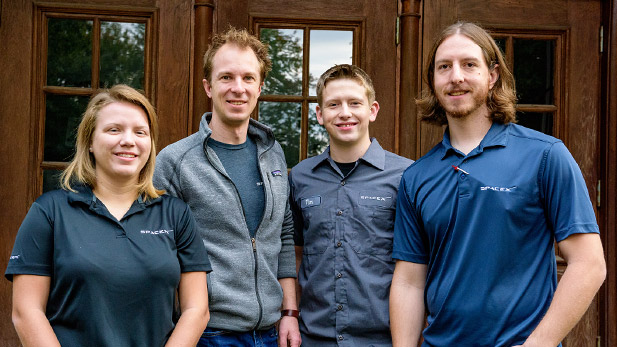Mechanical Engineering Alumni Help SpaceX Blast Off

Mechanical engineering alumni involved in a variety of SpaceX projects include (from left) Katie Piens, Steven Schmitz, Tim Balz and Jeff Van Treuren.
Several mechanical engineering alumni are playing key roles as SpaceX breaks new ground in space exploration, carrying humans to the International Space Station (ISS) and other destinations, while creating a constellation of satellites that could further enhance new technology.
On May 4, Space X launched its 17th commercial resupply services mission from Cape Canaveral Air Force Station in Florida. The Dragon spacecraft arrived at ISS two days later and will remain installed on the station for the rest of its four-week stay with the orbiting laboratory. SpaceX officials claim that Dragon is the only spacecraft currently flying that is capable of returning significant amounts of cargo to Earth.
Looking ahead, SpaceX is planning its first launch to carry a large number of Starlink broadband satellites this month – another part of entrepreneur Elon Musk’s vision to enable humans to become a spacefaring civilization and a multi-planet species by building a self-sustaining city on Mars.
Making all of this possible is reusable hardware for SpaceX’s Falcon Heavy and Falcon 9 rockets. Reusability significantly reduces the cost of spaceflight, with Falcon Heavy’s rocket having a $90 million price tag that is a third of the price of its closest competitor, according to the company.
SpaceX has already achieved five launches this year (four with the Falcon 9 rocket; one with Falcon Heavy) and is targeting 13 to 16 more blast offs for this year, not including the Starlink missions, according to Gwynne Shotwell, the company’s president and chief operating officer. That rate is consistent with previous years — SpaceX launched 18 times in 2017 and 21 times last year. Eventually, as many as 12,000 satellites could be scattered throughout Earth’s orbit.
Helping SpaceX reach these goals has been 2007 Rose-Hulman alumnus Steven Schmitz, who is a senior manager for SpaceX’s avionics mechanical engineering operations. He formerly supervised the design and analysis of avionics mechanical systems for the Falcon 9 and Dragon space flight vehicles, which led to the development of the Falcon Heavy rocket.
Meanwhile, Jeff Van Treuren (2010) is test director for space exploration technologies, including rocket development, at SpaceX’s operations in Texas.
Ben Lauer (2008) is lead build reliability engineer for sub-assemblies in SpaceX’s Dragon spacecraft, based in California.
Other alumni contributors include Katie Piens (2007), a build reliability engineer, and Tim Balz (2017), a launch engineer, both at SpaceX’s flight operations center at Cape Canaveral. In California are James Jones (2010), a manufacturing engineer for propulsion systems; Samuel Throne (2015), a structures engineer at SpaceX’s operations center; Spencer Jackson (ME, 2016), a structures engineer; and Brian Greenblatt (2017), an integration and test engineer.